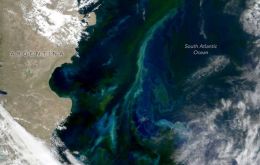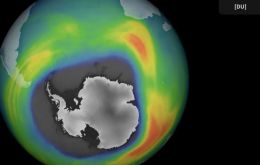MercoPress. South Atlantic News Agency
Tag: NASA
-
Monday, December 29th 2025 - 10:32 UTC
NASA Chief pledges lunar base shortly

Newly confirmed NASA Administrator Jared Isaacman has announced that the United States is accelerating its space agenda, with plans to return to the Moon and establish a permanent lunar base in the near future.
Add your comment! -
Wednesday, December 4th 2024 - 06:11 UTC
Patagonian Shelf Waters Abloo in austral spring, NASA Earth Observatory

An austral spring 2024, a phytoplankton bloom off the coast of Argentina painted the waters blue and green. Blooms are common in the region this time of year, but clouds often block the view from above.
-
Wednesday, January 24th 2024 - 10:32 UTC
NASA acknowledges Uruguay's striking advancements in wind energy integration

In a recent article, NASA's Science Mission Directorate commends Uruguay's impressive strides in rapidly incorporating wind energy into its electricity grid, spotlighting the Peralta wind farm in Tacuarembó, in the center of the country.
-
Monday, October 9th 2023 - 09:55 UTC
Copernicus satellite detected giant hole in ozone layer over Antarctica, three times the size of Brazil

The European Space agency Copernicus Sentinel satellite detected a giant hole in the ozone layer over Antarctica, as part of the EU's Environmental monitoring program. The hole which scientists call an “ozone depleted area” was 26 million square kilometers in size, roughly three times the size of Brazil.
-
Tuesday, August 1st 2023 - 20:26 UTC
NASA Chief says Argentine astronaut may soon travel to International Space Station

NASA's Administrator Bill Nelson said Monday while visiting the Teófilo Tabanera Space Center (CETT) of the National Space Activities Commission (Conae), in the town of Falda del Cañete in the Argentine province of Córdoba, that an astronaut from the South American country might soon be traveling to the International Space Station.
-
Friday, July 28th 2023 - 10:25 UTC
Argentina signs Artemis Accords with NASA

Argentine Science Minister Daniel Filmus Thursday signed the Artemis Accords during a ceremony at Casa Rosada with President Alberto Fernández, NASA Administrator Bill Nelson, US Ambassador Marc R. Stanley, and Foreign Minister Santiago Cafiero. Argentina became the 28th nation to sign the Accords, and the fifth Latin American country, following Brazil, Colombia, Ecuador, and Mexico.
-
Thursday, July 27th 2023 - 10:28 UTC
NASA Chief lands in Argentina

Former astronaut and current Administrator of the US National Aeronautics and Space Administration (NASA) Bill Nelson arrived Wednesday in Buenos Aires after a stop in Brazil on a South American tour that also includes Colombia.
-
Wednesday, July 26th 2023 - 10:30 UTC
Brazil working on satellite partnership with NASA

Brazilian Science Minister Luciana Santos Tuesday launched a proposition to United States Space Agency (NASA) Administrator Bill Nelson for both countries to develop together new satellites and aerospace technologies to monitor deforestation in the Amazon rainforest, Agencia Brasil reported.
-
Tuesday, May 10th 2022 - 09:41 UTC
British scientists support NASA rocket mission to uncover atmosphere secrets

The British Antarctic Survey, BAS, Space Weather team are supporting a new NASA experiment which aims to uncover unique features of our atmosphere that enable life on Earth.
-
Saturday, April 30th 2022 - 09:53 UTC
Partial solar eclipse on Saturday can be seen in southern South America, Falklands and Antarctica

The Earth is all set to witness its first solar eclipse of the year 2022, and according to NASA, this cosmic event will take place on Saturday, April 30, at around 6:45 PM UTC. Parts of South America, Antarctica and the Pacific and Southern Oceans will be able to witness this awe-inspiring phenomenon.
